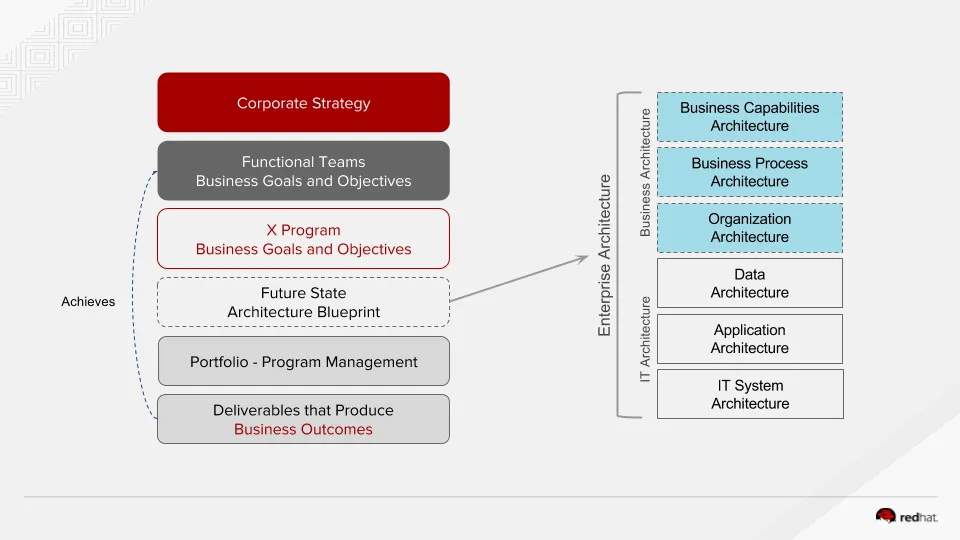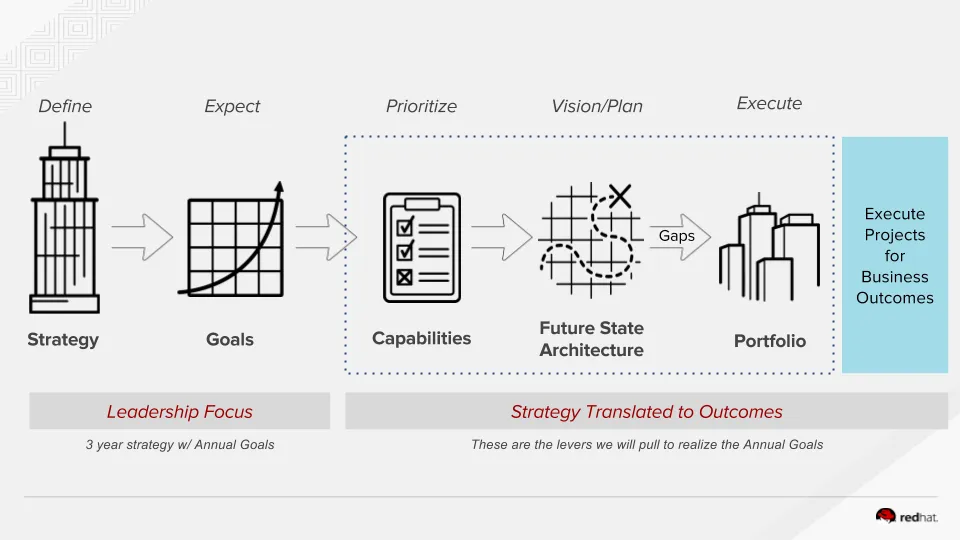Does your organization talk about connecting the execution of work to its strategy? Are you building a roadmap on how to get there and achieve desired goals? To help your organization achieve the strategy and goals, model the business architecture by understanding the organization's strategy, communicating business outcomes, and aligning these outcomes to the appropriate business capabilities.
Business architecture is illustrating what the business does and how the business operates. Gartner defines business capabilities as "what the business needs to do to achieve the business strategy.” Business architecture uses business capability modeling, to visualize and influence people, processes, and technologies needed to maximize stakeholder value, achieve organizational goals, and execute on the business strategy. This model should map out the future state capabilities needed to support where the business is going over multiple years, as defined by the organization's strategy.
Another main component of business architecture is business process design, according to Gartner, are what steps the business takes to run the business or "how a business works and/or operates." Defining the future state business processes should occur after the organization has chosen the capabilities to advance and/or deploy, in order to segway into delivering efficient and effective models that are executable and operational.
Figure 1 is a simple overview diagram that illustrates how the business architecture is aligned to strategies, goals, and business outcomes.
Business capabilities should deliver outcomes that will achieve the strategic goals set by leadership. Business process modeling define how and when the organization’s users execute the capabilities. The portfolio of work should deliver capabilities and modify processes that are defined in the organization’s collective agreement of a future state business capability model.
Figure 1
Leadership defines the strategy over a multi-year period and expects measurable annual goals or results that achieves the strategy. The business capabilities then should be documented and prioritized, and continually reviewed and improved. A vision or plan should state what the future business architecture should look like in order to effectively execute on the portfolio of work, thus start with a future state architecture before jumping into the projects or picking new technology tools. The projects in the portfolio should achieve the business outcomes that relate and measure against the strategy and goals of the organization.
The business architecture is directly integrated with the technical architecture to complete the enterprise architecture framework, as shown in Figure 2 below. This architecture framework highlights the full integration of business through technology that is achieved, in part, by showing the relationships between these components through architecture. The Business architecture, as stated previously, is made up of the capabilities and business processes mapped to the future state, as well as understanding the organization architecture, which is how the company is structured. The technical architecture is made up of the data, applications and systems that enable the business capabilities and processes to be performed and experienced by customers and partners.
Figure 2

Figure 2 is an evolution through feedback and continuously improving on the approach and modeling the architecture, as highlighted from the previous Architecture Core Diagram.
The architecture to strategy alignment is paramount to effectively plan and execute the enterprise portfolio, because it directly models the business to the multi-year business strategy and helps build a plan or roadmap to get there. The Strategy can then be translated into achieving outcomes that are the levers the entire business can pull to realize the annual goals for success.
Sobre el autor
Más similar
Navegar por canal
Automatización
Las últimas novedades en la automatización de la TI para los equipos, la tecnología y los entornos
Inteligencia artificial
Descubra las actualizaciones en las plataformas que permiten a los clientes ejecutar cargas de trabajo de inteligecia artificial en cualquier lugar
Nube híbrida abierta
Vea como construimos un futuro flexible con la nube híbrida
Seguridad
Vea las últimas novedades sobre cómo reducimos los riesgos en entornos y tecnologías
Edge computing
Conozca las actualizaciones en las plataformas que simplifican las operaciones en el edge
Infraestructura
Vea las últimas novedades sobre la plataforma Linux empresarial líder en el mundo
Aplicaciones
Conozca nuestras soluciones para abordar los desafíos más complejos de las aplicaciones
Programas originales
Vea historias divertidas de creadores y líderes en tecnología empresarial
Productos
- Red Hat Enterprise Linux
- Red Hat OpenShift
- Red Hat Ansible Automation Platform
- Servicios de nube
- Ver todos los productos
Herramientas
- Training y Certificación
- Mi cuenta
- Soporte al cliente
- Recursos para desarrolladores
- Busque un partner
- Red Hat Ecosystem Catalog
- Calculador de valor Red Hat
- Documentación
Realice pruebas, compras y ventas
Comunicarse
- Comuníquese con la oficina de ventas
- Comuníquese con el servicio al cliente
- Comuníquese con Red Hat Training
- Redes sociales
Acerca de Red Hat
Somos el proveedor líder a nivel mundial de soluciones empresariales de código abierto, incluyendo Linux, cloud, contenedores y Kubernetes. Ofrecemos soluciones reforzadas, las cuales permiten que las empresas trabajen en distintas plataformas y entornos con facilidad, desde el centro de datos principal hasta el extremo de la red.
Seleccionar idioma
Red Hat legal and privacy links
- Acerca de Red Hat
- Oportunidades de empleo
- Eventos
- Sedes
- Póngase en contacto con Red Hat
- Blog de Red Hat
- Diversidad, igualdad e inclusión
- Cool Stuff Store
- Red Hat Summit


